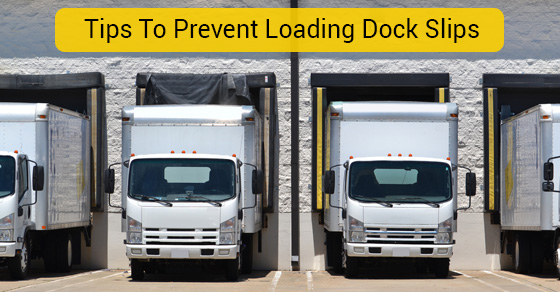When working on loading docks, it’s important to keep your workers safe. Slips and falls can occur regularly depending on outside conditions. To prevent loading dock slips try these five tips.
- Find the lightWhen a trailer is placed ready for loading or unloading, check out the perimeter around the trailer and dock leveller. If you can see light, the area needs to be sealed. If there’s light that means there is a gap that can let rain, snow, dust and outside contaminants into your warehouse.
- Seal the topWhen you use a head curtain or dock shelter along the top of the trailer, gaps can be common. Although head curtains and dock shelters can seal some gaps, you will need to make use of a secondary overhead sealing product. Try a product that uses weight and gravity to make a solid connection with the trailer’s top. The weight used creates a tight, consistent seal that stretches across the full width of the trailer. Because trailers have a tendency to bounce during the loading and unloading process, the weight of the sealing product should still be effective enough to stay in place.
- Seal the sidesBesides sealing the top of the dock, you will need to seal the sides as well. To keep the elements and other contaminants out people often opt for foam compression-style dock seals. Foam can bulge into the inside of the trailer when it’s compressed and can hinder the forklift loading process. It can also suffer wear and tear due to the constant friction it receives. Instead of using foam, try perimeter-sealing dock shelters. These are more effective than foam because they seal along the side of the trailer without bulging and can withstand friction.
- Vertical levellersTo keep environmental hazards out of dock openings, use vertical levellers. These types of levellers let the loading dock door close directly onto the pit floor, reducing outside air and water infiltration. Plus, when this configuration is used, trailer doors are opened inside the facility, leading to even more protection against outside contaminants.
- HVLS fansCondensation can also cause wet floors. When humid air enters the facility it condenses on surfaces that are at or below the dew point like the floor. This is referred to as sweating slab syndrome (SSS) because it will look like the floors are actually perspiring. To combat SSS install high-volume low-speed (HVLS) ceiling fans. These fans minimize temperature differentials so that condensation cannot accumulate on the floors leading to slips and falls.
Keeping your workers safe from loading dock hazards increases productivity and lets your employees know that you care about their wellbeing.


